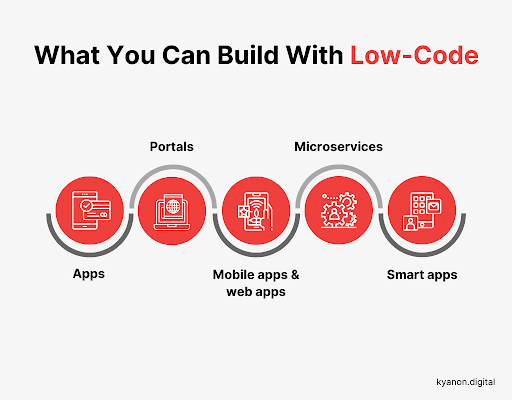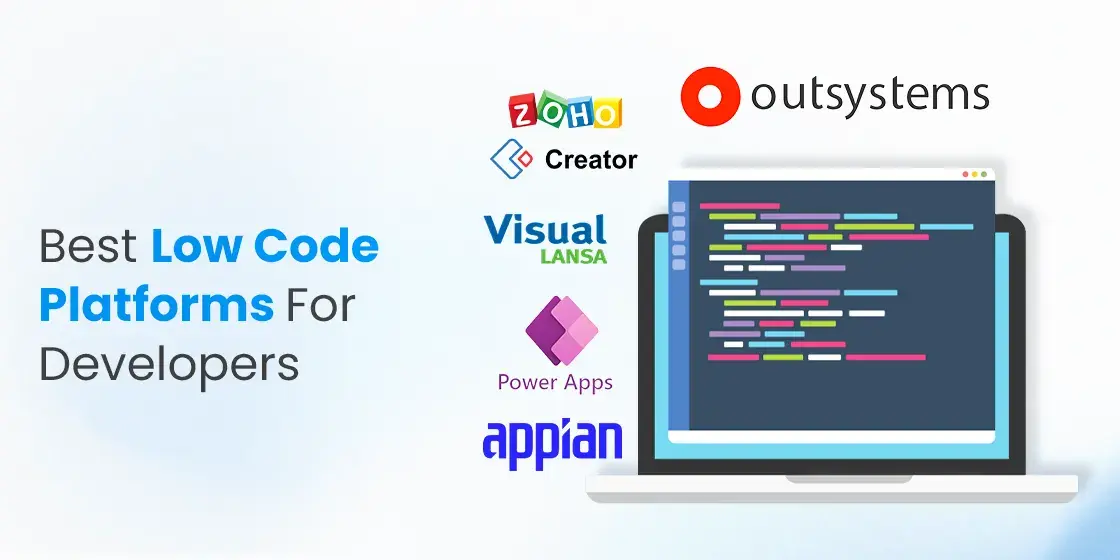Good Tips On Deciding On Low-code platforms for application development
Wiki Article
Benefits Of Low-Code Application Development In Terms Of Accessibility For Non-Developers
Low-code development of applications significantly increases accessibility for non-developers. Often, they are called "citizen developers" due to several key aspects: Intuitive visual interfaces:
Drag-and-drop Builders: Lowcode platforms provide drag-and-drop interfaces, which let non-developers create visual applications, without needing code. This allows development to be more accessible to people without technical backgrounds.
WYSIWYG Editors: "What You See Is What You Receive" editors allow users to build interfaces and workflows an approach that is similar to the actual product, which makes it simpler to use and understand.
Simplified workflow and logic
Visual Workflow Modelling: Users are able to design business processes, applications logic and flowcharts using models as well as visual flowcharts. These methods are much more intuitive than conventional coding techniques.
Pre-built Logical Components: Many low-code programs come with already-built logic components (e.g. conditions, loops) and can be easily set up. This reduces the necessity to write complicated programs.
Reusable Components and Templates
Libraries of pre-built templates: Many low-code platforms offer templates for common application types that allow non-programmers to begin with a solid foundation to alter as required.
Reusable widgets and modules by using modular or reusable widgets users can streamline the creation process, by eliminating the need for extensive technical knowledge.
Guided Development and Tutorials
Step-by-Step guide: Platforms provide instructions and help on screen to non-developers who are building applications.
Interactive Tutorials Interactive tutorials are interactive and hands-on and help users learn through doing. This increases the confidence of users in the platform.
Integration with Existing tools
Seamless Integrate: Low code platforms are designed to seamlessly integrate with the existing systems and tools in business (e.g. the ERP or CRM) that permits non-developers to build applications to work within current workflows.
APIs Connectors: APIs are integrated into applications to make integration easier. This allows non-developers, with no programming abilities, to connect to external services.
Collaboration Features:
Team Collaboration: Features like real-time collaboration workspaces and shared workspaces make it possible for non-developers to effectively collaborate with developers, business analyst, and other stakeholders.
Access control based on Role: Non developers are able to be assigned certain roles, with appropriate access levels. This enables them to contribute to the development without compromising security and performance.
Automated Debugging, Testing and Debugging
Low-code platforms are usually equipped with testing and debugging software that automates these procedures. This makes it much easier for non-developers to ensure that their applications function correctly.
Error Highlighting: When issues arise, the platform highlights errors and suggests fixes by guiding non-developers through troubleshooting steps.
Overall, the main advantage of developing applications using low-code for accessibility to non-developers comes in its ability to democratize the process of development. By providing intuitive, visual tools as well as guided experiences, low-code applications allow users of business to participate actively in developing and maintaining applications, which bridges the gap between business requirements and technical implementation. Have a look at the top Low-code Platform for application development for more recommendations including rapid applications, software for app development, low code platforms, low code development platforms, rapid action development, build with docker, rapid app development, build a docker container, driver jdbc, azure sql databases and more.

Flexibility And Scalability Are The Two Major Benefits Of Developing Applications Using Low-Code
Low-code applications offer a variety of advantages, particularly in terms of scaling. This is important to develop applications that expand with your company and adapt to grows. Here are a few key advantages.
Cloud-Based Deployment. Many low-code platforms have cloud-based deployments, which allows users to easily scale their applications by using cloud infrastructure. This lets businesses handle more workloads without having to worry about managing servers.
Auto-Scaling Functions: Auto scaling functions can be utilized to adjust resources automatically according to the demand. They guarantee that the performance remains consistent even during peak times.
Flexible Architecture:
Modular Application Design: Low-code platform promotes modular application design. Components can be independent tested, developed and scaled. This modularity enhances flexibility and allows to upgrade or expand certain components of an application without affecting the entire system.
Microservices Integration Support for microservices architecture allows applications to be constructed as a collection of loosely coupled service, increasing the scalability as well as flexibility.
Customizable Options:
Extensibility Low-code platforms usually allow custom coding and scripting. This lets developers enhance the capabilities of their applications beyond what is available out of the box. This allows businesses to satisfy the requirements of their particular business.
Third-Party Integrations: Businesses can incorporate additional functions and services into their apps through APIs and other third-party services.
Agile Development and deployment:
Continuous Delivery and Deployment: Low-code platforms are able to support agile methodologies, enabling continuous integration and continuous delivery (CI/CD). This allows rapid delivery of updates and new features, allowing apps to grow rapidly in response to customer feedback and changes to the market.
Iterative development low-code development is an iterative process and therefore applications can be scaled up and enhanced gradually. This minimizes the chance of major changes and allows a controlled growth.
Resource Optimization
Effective resource management: Platform tools that use low-code aid in optimizing resource usage by monitoring and managing the performance of the applications. They ensure that resources can be utilized effectively and efficiently can be scaled up or down in accordance with the needs of the moment.
Load Balancing : The integrated load balancing feature distributes workloads equally among servers. This improves the system's capacity to handle high traffic, and ensures consistent performance.
Global Reach
Multi-Region Integration: Low code platforms can be implemented across a variety of geographical regions. This enables companies to offer users high-quality, low-latency services across the world. This is particularly important when applications are popular with a worldwide user base.
Localization Support for Localization built in, which allows applications to be easily modified to accommodate various languages or regional needs. This allows for greater flexibility in diverse markets.
Updates and maintenance
Simple Maintenance: The visual and modular nature of low-code applications makes maintenance easier, allowing bugs and updates to be completed quickly and without lengthy downtime.
Version Control: Integrated version control systems allow for the safe deployment of updates and rollbacks. Older versions can be restored in the event that they're required.
Cost Efficiency:
Low Development Costs - By decreasing the amount of programming needed, low-code platforms can cut down on development costs. This makes it possible to increase the size of applications without increasing the development effort and expenditure.
Pay-Asyou-Go Models Many low code platforms offer flexible pricing for their services, including the pay-as-you go model, which ties prices to usage as well as growth. This provides financial flexibility.
In the end, low-code application development provides businesses with the flexibility and scalability that they need to build robust and flexible apps. These platforms permit quick adaption to changing needs, efficient resource usage, and continuous advancement. This guarantees that the application can evolve with the needs of the business. Take a look at the top rated Legacy application modernization with Low-code for site advice including software for app development, app development platform, develop cross platform mobile app, developing mobile apps, rapid app development, lowcode no code, develop web app, build with docker, cross platform app development, cross platform mobile development and more.

Benefits Of Developing Applications Using Low-Code In Terms Of Collaboration And Workflow
It's a great option for companies looking to boost team productivity by streamlining processes and improving collaboration. These are the major advantages.
Unified Development Environment Low-code platform provides an all-in-one environment which allows all the members of the team, including developers, analysts, designers, stakeholders and others, can effectively collaborate. This helps eliminate barriers.
Visual Development Tools: The visually, drag-and-drop nature of low-code tools makes it simpler for non-technical team members to participate in the development process, ensuring that business requirements are accurately recorded and implemented.
Communication Enhanced:
Real-Time Co-operation: Many platforms that use low-code support real-time co-operation features like commenting, editing in parallel and immediate feedback. They enable continuous communication by reducing the amount of time needed for back and forth discussion.
Shared Workspaces: Teams may work together in shared workspaces, in which they can review the, edit and debate project components, ensuring everyone's on the same page, and working towards the same goals.
A streamlined Workflow Management System:
Integrated Project Management Tools: A lot of low-code software platforms include integrated tools for project management that help teams monitor and organize their development projects. This includes the management of tasks, tracking progress and management of deadlines.
Workflow automation: Automating routine workflows and activities can reduce mistakes and manual labor, allowing teams and individuals to focus more on strategic projects and increase efficiency.
Speedier Iteration Cycles:
Rapid Prototyping : Low-code platforms allow rapid prototyping. They also allow rapid and iterative development. This allows teams to develop applications, test and refine them within a shorter period of time. This allows feedback to be rapidly integrated, and further improvements to be made.
Agile Development Support: Supporting agile methodology lets teams and individuals work in smaller increments. It allows them to swiftly adjust to changing circumstances.
Accessibility for non-developers
Citizen Development: Low-code platforms allow business users (citizens developers) to build and modify applications, with no extensive knowledge of coding. This reduces the burden on IT and development teams, and can provide faster responses to business needs.
Training and Onboarding Intuitive interfaces and extensive training materials make it easy for new team members to get up to speed improving the overall teamwork within the team.
Centralized Documentation, Knowledge Sharing, and Information Sharing
Integrated documentation Platform features that are low-code usually permit you to create and manage documents within the platform. All information about your project is centrally accessible and easy to access.
Knowledge Repositories: Teams can create and maintain knowledge repositories that include best practices, templates, and reuseable components, helping to facilitate sharing of knowledge and reducing the duplicate work.
Consistency and Standardization
Standardized Components: The use of pre-built, standardized components provides consistency between applications. This makes it simpler for the members of the team to understand different parts of a specific project and then work on these components.
Governance and compliance: Built into governance frameworks that ensure that every development adheres to the standards of the organization and regulations, minimizing non-compliance risks and ensuring the applications are of high-quality standards.
Feedback Loops and Improvement Loops
Integrated Feedback Mechanisms Low-code platforms usually have integrated feedback mechanisms, allowing users to easily provide feedback on applications, which can later be integrated into the development process.
Continuous Improvement: The capability for applications to quickly iterate and implement changes based off of feedback, while ensuring they are in line with the requirements of the user as well as business goals.
Visualization & Reporting
Real-Time Analysis Tools for reporting and analytics integrated into the software give instantaneous information about project progress, user interaction and performance. This allows an informed decision-making process based on data.
Visual Workflow mapping: Visual tools used to map workflows can be utilized by teams to improve workflows. This can help them pinpoint bottlenecks as well as areas for improvement.
For collaboration, low-code applications are a great way to streamline workflows, bring diverse teams together and automate tasks. This results in an efficient and flexible environment of development that is collaboration-oriented.
